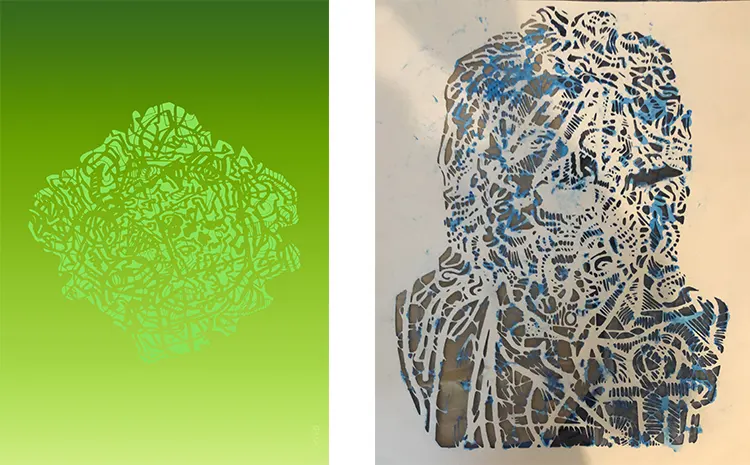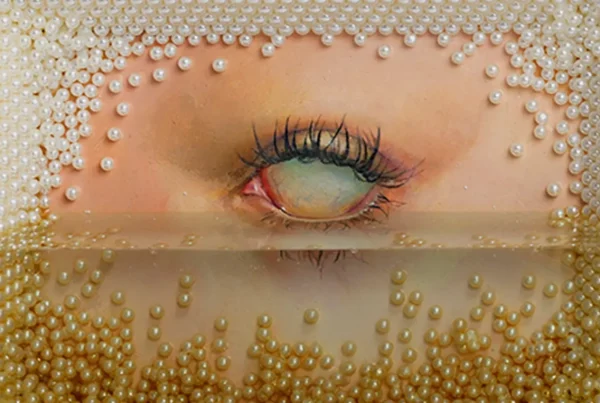“It made feel so much better that all the art I was making suddenly found a clear meaning: it was Hxoro.”
Artistic Awakening: Hxoro’s Journey to Self-Discovery
Emerging from a solitary saunter through the rain-swept streets of Bushwick, New York City, amid the tumult of the pandemic outbreak in 2020 and the rising wave of the Black Lives Matter movement, the artist known as “Hxoro” found himself at a crossroads. Jobless and facing an uncertain future, he discovered solace and inspiration in the most unexpected of places.
His attention was drawn to an abandoned, damp box by the side of the road. Within it, he discovered a book, a beacon of enlightenment during those troubled times. An excerpt from the text, penned by the psychologist Peter Green in 1999, described ‘Hxoro’ as the selfless act of giving characteristic of young children, which they undertake not with expectations of reciprocation, but merely to delight in the recipient’s reaction. This simple yet profound concept resonated deeply within him, instilling newfound clarity and purpose to his artistic endeavors. Henceforth, his artistry would embody this spirit of ‘Hxoro’.
A lifelong admirer of artists, Hxoro had been immersed in a milieu of music, art, and poetry since birth. His childhood was marked by an unending exploration of various creative mediums – playing musical instruments, sketching, painting, and crafting stories. However, it was not until he faced the adversity of unemployment amidst the pandemic in New York that he truly began to value his creative aptitude.
Propelled by this realization, he ventured into an art shop to procure canvas and paint, determined to mold his innate artistic flair into a cohesive style. Sequestering himself for an intense five-month period, Hxoro diligently honed his craft, each stroke of his brush bringing him a step closer to the distinct artistic identity he yearned to establish.
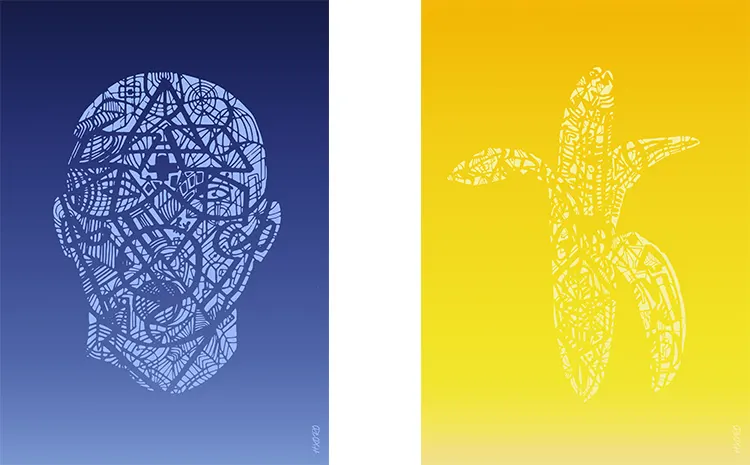
Illuminating Fears: Hxoro’s Symbolic Exploration
In the midst of life’s disarray, the unsettling process of deconstruction and reconstruction can stir profound emotions. This very sensation was the focus of Hxoro’s exploration as he found himself bracing for the impending expiry of his Visa. Amid the pressing time constraints, he channeled his energy into establishing reference points for his forthcoming series.
In an almost synchronous occurrence, the tragic death of George Floyd rocked the neighborhood of Bushwick in Brooklyn – one of the most critical areas at the time. Nighttime would find Hxoro immersed in his sketches, the echo of his neighbors firing shots into the sky as a defiant warning to the police, forming the surreal soundtrack to his work. This unprecedented situation spurred the artist’s motivation to express his sentiments through his art even further.
Hxoro’s seminal project, “72 Fears I Cannot See,” constitutes six subsets of twelve drawings each. These pieces function as symbolic representations of the fears the artist has grappled with personally. Each subset serves a dual purpose, both articulating a specific fear and providing a means to surmount it. Through the use of archetypal plants, animals, objects, idols, and shapes, Hxoro breathes life into these fears.
His artistic style embodies a form of therapeutic practice: he dismantles a figure into countless fragments, only to rearrange them, revealing an even more intimate view of its inner nature. The title “I cannot see them” reflects the nature of fear as an elusive darkness that obscures clarity and understanding. This project stands as a beacon of faint light, a desperate attempt to locate a reference point, akin to a child fumbling in the dark to find a light switch. The number seventy-two signifies the multitude of languages spoken at the Tower of Babel, another reflection of diversity and fragmentation that permeates the artist’s work.
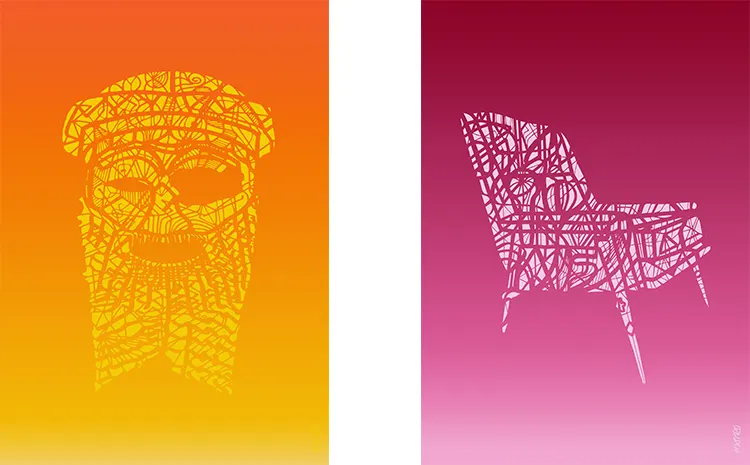
Mediums of Expression: Hxoro’s Versatile Artistic Repertoire
Hxoro consistently tailors his chosen medium to fit the requirements of each individual project. For the intricate collection entitled “72 Fears I Cannot See,” he employed markers of varying thicknesses to introduce a perceived depth within the shapes he painstakingly worked on. Conversely, for his vibrant stencil work, he utilizes fluorescent spray paint, specifically crafting pieces that only reveal themselves in the nocturnal cityscape, echoing the heightened fears that often strike in the night’s darkness. The artist’s repertoire extends further, employing diverse mediums such as oil, acrylics on canvas, and installations, demonstrating his versatile artistic expression.
The technique Hxoro employs often involves drawing on a 250-gram white paper using three distinct black markers, each with its unique thickness. The artist commences his work from a singular shape or subject, delineating its outer perimeter. The subsequent phase involves introducing thicker lines to define inner sections, subsequently fragmenting them into smaller slices. From here, the artist uses thinner lines to further dissect these sub-shapes into miniature figures, in a process that iteratively repeats until a point of saturation is reached. This system draws a path from large to small, outside to inside, encapsulating all within the artist’s vision. In Hxoro’s unique creative process, there are no erroneous strokes or mistakes, and each line contributes to the overall masterpiece. Once the shape is cut, he uses digital tools to invert the positive and negative spaces, forming the blueprint for a stencil to be cut. With the stencil prepared, Hxoro is equipped to paint his subject in any location.
Hxoro’s creative process has a unique relationship with distractions, viewing them as conduits for lateral thinking, particularly when dealing with matters of urgency. However, when deep within the artistic process, he has no qualms about disconnecting from all devices to immerse himself in focused creativity.
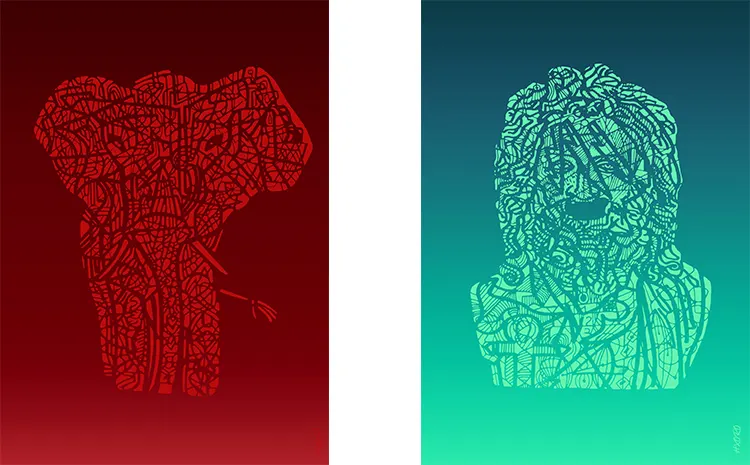
Influences and Ambitions: Hxoro’s Artistic Vision
Hxoro often credits the postmodern masters of the 1980s as primary influences on his work. Iconic figures such as Julian Schnabel, Basquiat, and Haring have undeniably left a profound mark on his artistic consciousness. Additionally, Hxoro appreciates the powerful and subversive narratives of Bansky, Imbue, Ryan Gander, and Lorenzo Quinn, extracting elements from their oeuvre to inform his own.
“Him” by Maurizio Cattelan holds a distinctive place in Hxoro’s artistic journey. Having personally encountered the piece, it struck a resonant chord within him, its provocative depiction of the dictator as a child inciting a turbulent cascade of emotions. This diminutive statue, simultaneously embodying the innocent child and the ruthless warlord responsible for countless atrocities in WWII, challenges the viewer’s perceptions. Hxoro underscores its historical value in the art world, being the pioneering work in tackling the war’s brutal reality through such an intimate yet controversial lens.
With regards to his ambitions, Hxoro envisions a grand display of his series of 72 drawings, desiring to share his entire portfolio in a cohesive exposition. Moreover, he harbors a passion for education, longing to impart his unique creative methodologies to a younger generation. Hxoro believes in the inherent creativity of children, cherishing the opportunity to guide them in exploring art without constraints, instilling in them the understanding that there are no erroneous lines, only boundless avenues of imagination.
